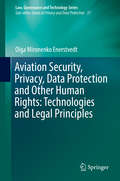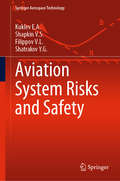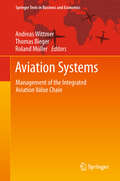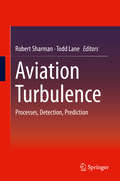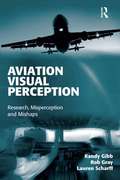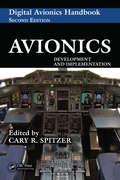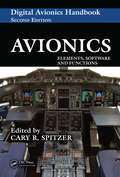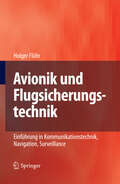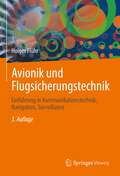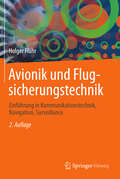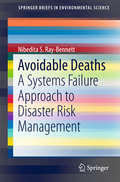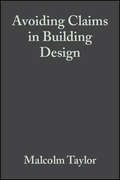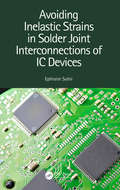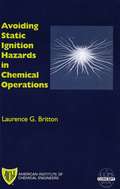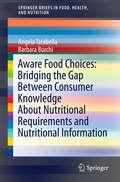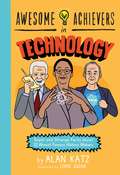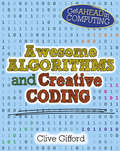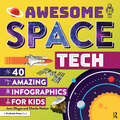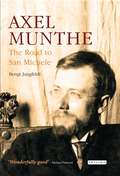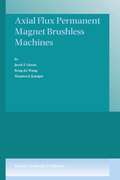- Table View
- List View
Aviation Security, Privacy, Data Protection and Other Human Rights: Technologies and Legal Principles (Law, Governance and Technology Series #37)
by Olga Mironenko EnerstvedtThis book sheds light on aviation security, considering both technologies and legal principles. It considers the protection of individuals in particular their rights to privacy and data protection and raises aspects of international law, human rights and data security, among other relevant topics. Technologies and practices which arise in this volume include body scanners, camera surveillance, biometrics, profiling, behaviour analysis, and the transfer of air passenger personal data from airlines to state authorities.Readers are invited to explore questions such as: What right to privacy and data protection do air passengers have? How can air passenger rights be safeguarded, whilst also dealing appropriately with security threats at airports and in airplanes? Chapters explore these dilemmas and examine approaches to aviation security which may be transferred to other areas of transport or management of public spaces, thus making the issues dealt with here of paramount importance to privacy and human rights more broadly. The work presented here reveals current processes and tendencies in aviation security, such as globalization, harmonization of regulation, modernization of existing data privacy regulation, mechanisms of self-regulation, the growing use of Privacy by Design, and improving passenger experience. This book makes an important contribution to the debate on what can be considered proportionate security, taking into account concerns of privacy and related human rights including the right to health, freedom of movement, equal treatment and non-discrimination, freedom of thought, conscience and religion, and the rights of the child. It will be of interest to graduates and researchers in areas of human rights, international law, data security and related areas of law or information science and technology. I think it will also be of interest to other categories (please see e.g. what the reviewers have written)"I think that the book would be of great appeal for airports managing bodies, regulators, Civil Aviation Authorities, Data Protection Authorities, air carriers, any kind of security companies, European Commission Transport Directorate, European Air Safety Agency (EASA), security equipment producers, security agencies like the US TSA, university researchers and teachers.""Lawyers (aviation, privacy and IT lawyers), security experts, aviation experts (security managers of airports, managers and officers from ANSPs and National Aviation Authorities), decision makers, policy makers (EASA, EUROCONTROL, EU commission)"
Aviation System Risks and Safety (Springer Aerospace Technology)
by Kuklev E.A. Shapkin V.S. Filippov V.L. Shatrakov Y.G.This book provides a solution to “rare event” problems without using the classical theory of reliability and theory of probability. This solution is based on the methodology of risk assessment as “measure of danger” (in keeping with the ICS RAS) and an expert approach to determining systems’ safety indications using Fuzzy Sets methods. Further, the book puts forward a new concept: “Reliability, Risks, and Safety” (RRS). The book’s main goal is to generalize present results and underscore the need to develop an alternative approach to safety level assessment and risk management for technical (aviation) systems in terms of Fuzzy Sets objects, in addition to traditional probabilistic safety analysis (PSA). The concept it proposes incorporates ICAO recommendations regarding proactive system control and the system’s responses to various internal and external disturbances.
Aviation Systems: Management of the Integrated Aviation Value Chain (Springer Texts in Business and Economics)
by Andreas Wittmer, Thomas Bieger and Roland MüllerThis book aims to provide comprehensive coverage of the field of air transportation, giving attention to all major aspects, such as aviation regulation, economics, management and strategy. The book approaches aviation as an interrelated economic system and in so doing presents the “big picture” of aviation in the market economy. It explains the linkages between domains such as politics, society, technology, economy, ecology, regulation and how these influence each other. Examples of airports and airlines, and case studies in each chapter support the application-oriented approach. Students and researchers in business administration with a focus on the aviation industry, as well as professionals in the industry looking to refresh or broaden their knowledge of the field will benefit from this book.
Aviation Turbulence: Processes, Detection, Prediction
by Robert Sharman Todd LaneAnyone who has experienced turbulence in flight knows that it is usually not pleasant, and may wonder why this is so difficult to avoid. The book includes papers by various aviation turbulence researchers and provides background into the nature and causes of atmospheric turbulence that affect aircraft motion, and contains surveys of the latest techniques for remote and in situ sensing and forecasting of the turbulence phenomenon. It provides updates on the state-of-the-art research since earlier studies in the 1960s on clear-air turbulence, explains recent new understanding into turbulence generation by thunderstorms, and summarizes future challenges in turbulence prediction and avoidance.
Aviation Visual Perception: Research, Misperception and Mishaps (Ashgate Studies in Human Factors for Flight Operations)
by Randy Gibb Rob Gray Lauren ScharffVision is the dominant sense used by pilots and visual misperception has been identified as the primary contributing factor in numerous aviation mishaps, resulting in hundreds of fatalities and major resource loss. Despite physiological limitations for sensing and perceiving their aviation environment, pilots can often make the required visual judgments with a high degree of accuracy and precision. At the same time, however, visual illusions and misjudgments have been cited as the probable cause of numerous aviation accidents, and in spite of technological and instructional efforts to remedy some of the problems associated with visual perception in aviation, mishaps of this type continue to occur. Clearly, understanding the role of visual perception in aviation is key to improving pilot performance and reducing aviation mishaps. This book is the first dedicated to the role of visual perception in aviation, and it provides a comprehensive, single-source document encompassing all aspects of aviation visual perception. Thus, this book includes the foundations of visual and vestibular sensation and perception; how visual perceptual abilities are assessed in pilots; the pilot's perspective of visual flying; a summary of human factors research on the visual guidance of flying; examples of specific visual and vestibular illusions and misperceptions; mishap analyses from military, commercial and general aviation; and, finally, how this knowledge is being used to better understand visual perception in aviation's next generation. Aviation Visual Perception: Research, Misperception and Mishaps is intended to be used for instruction in academia, as a resource for human factors researchers, design engineers, and for instruction and training in the pilot community.
Aviation Visual Perception: Research, Misperception and Mishaps (Ashgate Studies in Human Factors for Flight Operations)
by Randy Gibb Rob Gray Lauren ScharffVision is the dominant sense used by pilots and visual misperception has been identified as the primary contributing factor in numerous aviation mishaps, resulting in hundreds of fatalities and major resource loss. Despite physiological limitations for sensing and perceiving their aviation environment, pilots can often make the required visual judgments with a high degree of accuracy and precision. At the same time, however, visual illusions and misjudgments have been cited as the probable cause of numerous aviation accidents, and in spite of technological and instructional efforts to remedy some of the problems associated with visual perception in aviation, mishaps of this type continue to occur. Clearly, understanding the role of visual perception in aviation is key to improving pilot performance and reducing aviation mishaps. This book is the first dedicated to the role of visual perception in aviation, and it provides a comprehensive, single-source document encompassing all aspects of aviation visual perception. Thus, this book includes the foundations of visual and vestibular sensation and perception; how visual perceptual abilities are assessed in pilots; the pilot's perspective of visual flying; a summary of human factors research on the visual guidance of flying; examples of specific visual and vestibular illusions and misperceptions; mishap analyses from military, commercial and general aviation; and, finally, how this knowledge is being used to better understand visual perception in aviation's next generation. Aviation Visual Perception: Research, Misperception and Mishaps is intended to be used for instruction in academia, as a resource for human factors researchers, design engineers, and for instruction and training in the pilot community.
Avionics: Development and Implementation (The Avionics Handbook, Second Edition)
by Cary R. SpitzerRenamed to reflect the increased role of digital electronics in modern flight control systems, Cary Spitzer's industry-standard Digital Avionics Handbook, Second Edition is available in two comprehensive volumes designed to provide focused coverage for specialists working in different areas of avionics development. The second installment, Avionics: Development and Implementation explores the practical side of avionics. The book examines such topics as modeling and simulation, electronic hardware reliability, certification, fault tolerance, and several examples of real-world applications. New chapters discuss RTCA DO-297/EUROCAE ED-124 integrated modular avionics development and the Genesis platform.
Avionics: Development and Implementation (The Avionics Handbook, Second Edition)
by Cary R. SpitzerRenamed to reflect the increased role of digital electronics in modern flight control systems, Cary Spitzer's industry-standard Digital Avionics Handbook, Second Edition is available in two comprehensive volumes designed to provide focused coverage for specialists working in different areas of avionics development. The second installment, Avionics: Development and Implementation explores the practical side of avionics. The book examines such topics as modeling and simulation, electronic hardware reliability, certification, fault tolerance, and several examples of real-world applications. New chapters discuss RTCA DO-297/EUROCAE ED-124 integrated modular avionics development and the Genesis platform.
Avionics: Elements, Software and Functions (The Avionics Handbook, Second Edition)
by Cary R. SpitzerRenamed to reflect the increased role of digital electronics in modern flight control systems, Cary Spitzer's industry-standard Digital Avionics Handbook, Second Edition is available in two comprehensive volumes designed to provide focused coverage for specialists working in different areas of avionics development. The first installment, Avionics: Elements, Software, and Functions covers the building blocks and enabling technologies behind modern avionics systems. It discusses data buses, displays, human factors, standards, and flight systems in detail and includes new chapters on the Time-Triggered Protocol (TTP), ARINC specification 653, communications, and vehicle health management systems.
Avionics: Elements, Software and Functions (The Avionics Handbook, Second Edition)
by Cary R. SpitzerRenamed to reflect the increased role of digital electronics in modern flight control systems, Cary Spitzer's industry-standard Digital Avionics Handbook, Second Edition is available in two comprehensive volumes designed to provide focused coverage for specialists working in different areas of avionics development. The first installment, Avionics: Elements, Software, and Functions covers the building blocks and enabling technologies behind modern avionics systems. It discusses data buses, displays, human factors, standards, and flight systems in detail and includes new chapters on the Time-Triggered Protocol (TTP), ARINC specification 653, communications, and vehicle health management systems.
Avionik und Flugsicherungstechnik: Einführung in Kommunikationstechnik, Navigation, Surveillance
by Holger FlührDas Lehrbuch spannt den Bogen von Flugsicherungs-Technologien über Avioniksysteme (Kommunikation, Navigation, Surveillance) sowie die bordautonome Energieversorgung bis hin zur Integration der Systeme im Flugzeug. Neben der Beschreibung von Funktion und Aufbau der Teilsysteme behandelt der Autor deren Einbindung in die Avionikumgebung des Flugzeugs und die Bodeninfrastruktur. Notwendiges nachrichtentechnisches Wissen wird wiederholt, die Definition von Lernzielen, Verständnisfragen und beispielhafte Aufgaben sichern den Lernerfolg.
Avionik und Flugsicherungstechnik: Einführung in Kommunikationstechnik, Navigation, Surveillance
by Holger FlührDas Buch spannt den Bogen von modernen Technologien zur Flugsicherung über die wesentlichen Avioniksysteme (Kommunikation, Navigation, Surveillance) sowie die bordautonome Energieversorgung bis hin zur Integration der Systeme im Flugzeug. Der Autor legt Wert auf die Einbindung der vorgestellten Funktionsblöcke in das System Flugzeug bzw. in das System Luftfahrt: Er behandelt sowohl Funktion und Aufbau der Teilsysteme als auch deren Einbindung in die Avionikumgebung des Flugzeugs und in die Bodeninfrastruktur. Ein weiteres Thema sind zulassungsspezifische Fragestellungen. Zum Verständnis notwendige nachrichtentechnische Kenntnisse werden komprimiert wiederholt. Der Lernerfolg wird durch Definition von Lernzielen, Verständnisfragen und Beispielaufgaben sichergestellt. Die 2., komplett durchgesehene Auflage erweitert vor allem die Ausführungen zur Zuverlässigkeit von Flugzeugsystemen und lässt aktuelle Entwicklungen wie etwa SESAR in den Text einfließen.
Avionik und Flugsicherungstechnik: Einführung in Kommunikationstechnik, Navigation, Surveillance
by Holger FlührDas Buch spannt den Bogen von modernen Technologien zur Flugsicherung über die wesentlichen Avioniksysteme (Kommunikation, Navigation, Surveillance) sowie die bordautonome Energieversorgung bis hin zur Integration der Systeme im Flugzeug. Der Autor legt Wert auf die Einbindung der vorgestellten Funktionsblöcke in das System Flugzeug bzw. in das System Luftfahrt: Er behandelt sowohl Funktion und Aufbau der Teilsysteme als auch deren Einbindung in die Avionikumgebung des Flugzeugs und in die Bodeninfrastruktur. Ein weiteres Thema sind zulassungsspezifische Fragestellungen. Zum Verständnis notwendige nachrichtentechnische Kenntnisse werden komprimiert wiederholt. Der Lernerfolg wird durch Definition von Lernzielen, Verständnisfragen und Beispielaufgaben sichergestellt. Die 2., komplett durchgesehene Auflage erweitert vor allem die Ausführungen zur Zuverlässigkeit von Flugzeugsystemen und lässt aktuelle Entwicklungen wie etwa SESAR in den Text einfließen.
Avoidable Deaths: A Systems Failure Approach to Disaster Risk Management (SpringerBriefs in Environmental Science)
by Nibedita S. Ray-BennettThis book addresses one of the most fundamental questions of the 21st century: why deaths continue to occur in natural disasters despite the tremendous advancements in disaster management science and weather forecasting systems, increased sophistication of human-built environments and ongoing economic and policy development worldwide. By presenting an interdisciplinary tool for analysing ‘systems failure’, the book provides concrete suggestions on how deaths may be reduced in resource-poor contexts. It goes beyond traditional risk and vulnerability perspectives and demonstrates that deaths in disasters are complex problems that can be solved by adopting a socio-technical perspective to improve current disaster management systems in the developing world. The book is a timely contribution, as it directly addresses Global Target One of the UN’s ‘Sendai Framework for Disaster Risk Reduction’, which has urged 185 UN Member States to reduce disaster mortality by 2030. Further, it offers a valuable resource for students, researchers, policy-makers and practitioners interested in disaster risk reduction, human rights, gender, sociology of risk, crisis and disasters, environmental science, organisation and management studies.
Avoiding Claims in Building Design: Risk Management in Practice
by Malcolm TaylorThe chance of being claimed against is now a major risk factor for every building designer, engineer, quantity surveyor and project manager. Apart from the cases that go to court, many other claims are settled before they reach that stage. The cost of insurance to meet claims is now a substantial component of every practice's overheads. Sensible risk management can identify the potential sources of claims, reduce their likelihood, warn of impending trouble and control how the claim is to be defended. This book explains how to plan a risk management strategy and suggests techniques that can supplement the practice's existing management procedures without imposing unnecessary bureaucracy. It attaches as much importance to the interaction of risk between members of the design team as to the risk profile of the practice itself. The first part defines risk and its origins, discusses how risk can arise in the various professions and types of practice, and how it interacts between the professions, compares quality assurance with risk management, and advises on the relations between the practice, its insurers and its lawyers. It concludes with advice on how to create a risk strategy and system for the office. The second part is devoted to techniques and covers: setting up the appointment; creation of the team; managing the project; the risks of CDM; the complications of procurement; and drafting, awarding and administering the building contract. Risk implications of the major contract forms are discussed in detail. It concludes with advice on the handling of claims. The book contains references to a number of legal cases to illustrate the risks discussed. It is recommended reading not only for the individual professions (architect, engineer, QS, project manger), but for all of them collectively in understanding how the risk of one profession can become the risk of any of his fellow team members.
Avoiding Inelastic Strains in Solder Joint Interconnections of IC Devices
by Ephraim SuhirAvoiding Inelastic Strains in Solder Joint Interconnections of IC Devices addresses analytical (mathematical) modeling approaches aimed at understanding the underlying physics and mechanics of the behavior and performance of solder materials and solder joint interconnections of IC devices. The emphasis is on design for reliability, including probabilistic predictions of the solder lifetime. Describes how to use the developed methods of analytical predictive modeling to minimize thermal stresses and strains in solder joint of IC devices Shows how to build the preprocessing models in finite-element analyses (FEA) by comparing the FEA and analytical data Covers how to design the most effective test vehicles for testing solder joints Details how to design and organize, in addition to or sometimes even instead of highly accelerated life tests (HALT), highly focused and highly cost-effective failure oriented accelerated testing (FOAT) to understand the physic of failure of solder joint interconnections Outlines how to convert the low cycle fatigue conditions into elastic fatigue conditions and to assess the fatigue lifetime in such cases Illustrates ways to replace time- and labor-consuming, expensive, and possibly misleading temperature cycling tests with simpler and physically meaningful accelerated tests This book is aimed towards professionals in electronic and photonic packaging, electronic and optical materials, materials engineering, and mechanical design.
Avoiding Static Ignition Hazards in Chemical Operations: A CCPS Concept Book (A CCPS Concept Book #20)
by Laurence G. BrittonWritten by Laurence Britton, who has over 20 years' experience in the fields of static ignition and process fire and explosion hazards research, this resource addresses an area not extensively covered in process safety standards or literature: understanding and reducing potential hazards associated with static electricity. The book covers the nature of static electricity, characteristics and effective energies of different static resources, techniques for evaluating static electricity hazards, general bonding, grounding, and other techniques used to control static or prevent ignition, gases and liquids, powders and hybrid mixtures.
The Awakening Desert: The Autobiography of an Israeli Scientist
by Michael EvenariMichael Evenari's biography unfolds his exciting, manifold life: his love for botany, the confrontation with political events as a youngster and his thrilling experience of helping in the development of Israel. Evenari takes us on his exciting expeditions in the company of his beloved wife. He tells us of his meetings with many personalities and about his farm in the Negev. The discovery of long forgotten floodwater irrigated farm systems from the times of King Salomon and their reconstruction became a successful experiment which lead him to teach this approach of runoff agriculture in many parts of the world, initializing progress in the development of various arid areas. As a tribute to his successful scientific life, Evenari was awarded the Balzan Prize in 1988. In April 1989, Michael Evenari died at the age of 84.
Aware Food Choices: Bridging the Gap Between Consumer Knowledge About Nutritional Requirements and Nutritional Information (SpringerBriefs in Food, Health, and Nutrition)
by Angela Tarabella Barbara BurchiThis Brief provides a snapshot of the continuing debate in the food industry on how to bridge the gap between consumer knowledge of nutrition principles and the nutrition information system currently in place for labelling. Aware Food Choices: Bridging the Gap Between Consumer Knowledge About Nutrition and Nutritional Information examines the available literature on consumer understanding of nutritional information and comments on the current poor knowledge shown by consumers about nutrition principles. Another focus of this Brief is on the evolution of nutritional information in food labelling andcurrent regulations on nutritional claims and product facts. In reviewing attempts to improve the nutrition information system, this work points out that consumers must first understand the data provided in order to utilize the system to make healthy food choices. Therefore, any campaigns aimed at improving the information system must concentrate on consumer data understanding of nutrition principles and components as opposed to a sole focus on labelling upgrades.
Awesome Achievers in Technology: Super and Strange Facts about 12 Almost Famous History Makers (Awesome Achievers)
by Alan KatzPart of a super fun middle grade series, Awesome Achievers in Technology puts the spotlight on lesser-known heroes and their contributions in tech.Everyone has heard the name Steve Jobs, but what about Nolan Bushnell--Jobs's boss before the invention of Apple, and the founder of the first major video game, Pong? Many of the most relevant figures in tech history have remained in the shadows, but not any longer! From Alan Katz's new Awesome Achievers series, Awesome Achievers in Technology gives kids a look behind the scenes at 12 lesser-known inventors whose contributions to tech are personally relevant to their lives today. Each figure is given a traditional biography but is also subject to Katz's unique brand of silliness, with humorous elements such as imagined poems, song lyrics, and diary entries by and about the not-so-famous figure accompanying each bio. Spot illustrations throughout add to the lighthearted and appreciative humor each figure receives. Reluctant readers and budding tech enthusiasts alike will delight in this imaginative and engaging introduction to a new series of laugh out loud biographies.
Awesome Algorithms & Creative Coding (Get Ahead in Computing #2)
by Clive GiffordAwesome Algorithms and Creative Coding explores how computers work and explains how to think in a logical way. The bright and engaging design guides readers through clear explanations of binary code, simple algorithms and computer language. With real-life examples readers learn about the development of coding using simple decision making processes. Looks at programming languages that readers can use themselves, including Scratch and LOGO. Stretch Yourself features give practical activities to help readers explore and test key principles. These 'try at home' examples help reinforce learning and are not linked to specific software or operating systems. True Story features give real-world anecdotes from the world of information technology. Computer Hero features look at the forerunners of digital technology that have paved the way for scientists today.Get Ahead in Computing is a practical and much-needed resource for the KS1-2 computing curriculum exploring all aspects of computational thinking. The series breaks down this new curriculum subject into four titles covering key topics: computer science, algorithms & coding, applications & programs, and computer networks.Ideal for young readers starting the new Computing curriculum subject in school.Other titles in the Get Ahead in Computing series: The Science of Computers, Amazing Applications & Perfect Programs, and Computer Networks.
Awesome Space Tech: 40 Amazing Infographics for Kids
by Jennifer Dlugos Charlie HattonSpace may be the "final frontier"—but how do we learn about it, look deeper into it, and live in it? The infographics in this book will rocket you through a universe of powerful telescopes, distant probes, and high-speed spacecraft. Get ready to buzz by comets, land on alien planets, peer into the universe's past, and go where no one (except a handful of rovers and space probes) has gone before! We live in a complicated cosmos, but this book breaks down the complex, the confusing, and the downright kooky to reveal the fascinating details and hidden wonders that are out of this world.Ages 9-12
Awesome Space Tech: 40 Amazing Infographics for Kids
by Jennifer Dlugos Charlie HattonSpace may be the "final frontier"—but how do we learn about it, look deeper into it, and live in it? The infographics in this book will rocket you through a universe of powerful telescopes, distant probes, and high-speed spacecraft. Get ready to buzz by comets, land on alien planets, peer into the universe's past, and go where no one (except a handful of rovers and space probes) has gone before! We live in a complicated cosmos, but this book breaks down the complex, the confusing, and the downright kooky to reveal the fascinating details and hidden wonders that are out of this world.Ages 9-12
Axel Munthe: The Road to San Michele
by Bengt JangfeldtAxel Munthe: The Road to San Michele' tells for the first time the riveting life-story of an extraordinary individual, who came to define the times he lived in. The precociously bright son of a Swedish pharmacist, Axel Munthe worked under Jean Martin Charcot, and in 1880, became the youngest doctor in French history. By the 1890s, he was world-famous for his healing powers, believed by some to be supernatural. He moved in the most colourful and exalted circles of fin de siecle Europe, counting amongst his friends Henry James, Howard Carter, Rainer Maria Rilke, Lady Ottoline Morrell and Count Zeppelin. Though physician to the Swedish court, where he became the lover of the Crown Princess Victoria, Munthe was more at home with nature than with people. He travelled through remotest Lapland, as well as across Europe, and his great love was animals, whom he went to great lengths to protect. In 1929 he published 'The Story of San Michele', an account of his life, shot through with his love for Italy and Capri, where he built a bird sanctuary and the house of his dreams, the Villa San Michele. The book became an international best seller, translated into 40 languages, and has become one of the classics of the last century. Bengt Jangfeldt is the first person to have gone through Munthe's diaries, letters and notebooks to produce this definitive account of one of 20th Century Europe's most vibrant figures. Written with the verve and exuberance of its subject, 'Axel Munthe: The Road to San Michele' evokes a lost time, a life of passions, and a man who believed in every sense in the power of dreams.
Axial Flux Permanent Magnet Brushless Machines
by Jacek F. Gieras Rong-Jie Wang Maarten J. KamperAxial Flux Permanent Magnet (AFPM) brushless machines are modern electrical machines with a lot of advantageous merits over their conventional counterparts. They are increasingly used in power generation, domestic appliances, industrial drives, electric vehicles, and marine propulsion drives and many other applications. This book deals with the analysis, construction, design, optimisation, control and applications of AFPM machines. The authors present their own research results, as well as significant research contributions made by others. This monograph will be of interest to electrical engineers and other engineers involved in the design and application of AFPM brushless machine drives. It will be an important resource for researchers and graduate students in the field of electrical machine and drives.
